Towards Sustainable Cities: Utilizing Floating Car Data to Support Location-Based Road Network Performance Measurements
Abstract
:1. Introduction
2. Literature Review
2.1. Fundamentals on Road Network Performance Measurements
2.2. Road Network Data Collection: Developing A New Method
3. Methodology
3.1. Basic Idea
3.2. Detour
3.3. Infrastructure
3.4. Traffic Congestion
3.5. Speed Comparison
3.6. Area Comparison
4. Case Study: Comparison of Four German Cities by Detour, Infrastructure and Traffic Congestion Indices and Their Impact on Road Network Performance
4.1. Detour Factor
4.2. Travel Times
4.3. Transportation Costs
4.4. City Comparison
5. Discussion
6. Limitations and Further Research
7. Conclusions
Author Contributions
Funding
Conflicts of Interest
References
- Cividino, S.; Halbac-Cotoara-Zamfir, R.; Salvati, L. Revisiting the “City Life Cycle”: Global Urbanization and Implications for Regional Development. Sustainability 2020, 12, 1151. [Google Scholar] [CrossRef] [Green Version]
- Ameen, R.F.M.; Mourshed, M. Urban sustainability assessment framework development: The ranking and weighting of sustainability indicators using analytic hierarchy process. Sustain. Cities Soc. 2019, 44, 356–366. [Google Scholar] [CrossRef]
- Huang, S.-L.; Wong, J.-H.; Chen, T.-C. A framework of indicator system for measuring Taipei’s urban sustainability. Landsc. Urban Plan. 1998, 42, 15–27. [Google Scholar] [CrossRef]
- Tang, J.; Zhu, H.-L.; Liu, Z.; Jia, F.; Zheng, X.-X. Urban Sustainability Evaluation under the Modified TOPSIS Based on Grey Relational Analysis. Int. J. Environ. Res. Public Health 2019, 16, 256. [Google Scholar] [CrossRef] [PubMed] [Green Version]
- Verma, P.; Raghubanshi, A.S. Urban sustainability indicators: Challenges and opportunities. Ecol. Indic. 2018, 93, 282–291. [Google Scholar] [CrossRef]
- Gillis, D.; Semanjski, I.; Lauwers, D. How to Monitor Sustainable Mobility in Cities? Literature Review in the Frame of Creating a Set of Sustainable Mobility Indicators. Sustainability 2016, 8, 29. [Google Scholar] [CrossRef] [Green Version]
- Shen, L.-Y.; Jorge Ochoa, J.; Shah, M.N.; Zhang, X. The application of urban sustainability indicators–A comparison between various practices. Habitat Int. 2011, 35, 17–29. [Google Scholar] [CrossRef]
- Li, F.; Su, Y.; Xie, J.; Zhu, W.; Wang, Y. The Impact of High-Speed Rail Opening on City Economics along the Silk Road Economic Belt. Sustainability 2020, 12, 3176. [Google Scholar] [CrossRef] [Green Version]
- Zhang, X.; Guan, H.; Zhu, H.; Zhu, J. Analysis of Travel Mode Choice Behavior Considering the Indifference Threshold. Sustainability 2019, 11, 5495. [Google Scholar] [CrossRef] [Green Version]
- Ortega, J.; Tóth, J.; Péter, T.; Moslem, S. An Integrated Model of Park-And-Ride Facilities for Sustainable Urban Mobility. Sustainability 2020, 12, 4631. [Google Scholar] [CrossRef]
- Li, X.-H.; Huang, L.; Li, Q.; Liu, H.-C. Passenger Satisfaction Evaluation of Public Transportation Using Pythagorean Fuzzy MULTIMOORA Method under Large Group Environment. Sustainability 2020, 12, 4996. [Google Scholar] [CrossRef]
- Hamurcu, M.; Eren, T. Strategic Planning Based on Sustainability for Urban Transportation: An Application to Decision-Making. Sustainability 2020, 12, 3589. [Google Scholar] [CrossRef]
- Gumbo, T.; Moyo, T. Exploring the Interoperability of Public Transport Systems for Sustainable Mobility in Developing Cities: Lessons from Johannesburg Metropolitan City, South Africa. Sustainability 2020, 12, 5875. [Google Scholar] [CrossRef]
- Castanho, R.A.; Behradfar, A.; Vulevic, A.; Naranjo Gómez, J.M. Analyzing Transportation Sustainability in the Canary Islands Archipelago. Infrastructures 2020, 5, 58. [Google Scholar] [CrossRef]
- Fernandes, P.; Vilaça, M.; Macedo, E.; Sampaio, C.; Bahmankhah, B.; Bandeira, J.M.; Guarnaccia, C.; Rafael, S.; Fernandes, A.P.; Relvas, H.; et al. Integrating road traffic externalities through a sustainability indicator. Sci. Total Environ. 2019, 691, 483–498. [Google Scholar] [CrossRef]
- Mahmoudi, R.; Shetab-Boushehri, S.-N.; Hejazi, S.R.; Emrouznejad, A. Determining the relative importance of sustainability evaluation criteria of urban transportation network. Sustain. Cities Soc. 2019, 47, 101493. [Google Scholar] [CrossRef] [Green Version]
- Ruiz, A.; Guevara, J. Sustainable Decision-Making in Road Development: Analysis of Road Preservation Policies. Sustainability 2020, 12, 872. [Google Scholar] [CrossRef] [Green Version]
- Wang, S.; Yu, D.; Kwan, M.-P.; Zhou, H.; Li, Y.; Miao, H. The Evolution and Growth Patterns of the Road Network in a Medium-Sized Developing City: A Historical Investigation of Changchun, China, from 1912 to 2017. Sustainability 2019, 11, 5307. [Google Scholar] [CrossRef] [Green Version]
- Liu, J.; Lu, H.; Chen, M.; Wang, J.; Zhang, Y. Macro Perspective Research on Transportation Safety: An Empirical Analysis of Network Characteristics and Vulnerability. Sustainability 2020, 12, 6267. [Google Scholar] [CrossRef]
- Calvo-Poyo, F.; Navarro-Moreno, J.; de Oña, J. Road Investment and Traffic Safety: An International Study. Sustainability 2020, 12, 6332. [Google Scholar] [CrossRef]
- Mondschein, A.; Taylor, B.D. Is traffic congestion overrated? Examining the highly variable effects of congestion on travel and accessibility. J. Transp. Geogr. 2017, 64, 65–76. [Google Scholar] [CrossRef]
- Figliozzi, M.A. The impacts of congestion on commercial vehicle tour characteristics and costs. Transp. Res. Part E Logist. Transp. Rev. 2010, 46, 496–506. [Google Scholar] [CrossRef]
- McKinnon, A. The Effect of Traffic Congestion on the Efficiency of Logistical Operations. Int. J. Logist. Res. Appl. 1999, 2, 111–128. [Google Scholar] [CrossRef]
- Dewees, D.N. Estimating the Time Costs of Highway Congestion. Econometrica 1979, 47, 1499. [Google Scholar] [CrossRef]
- Weisbrod, G.; Vary, D.; Treyz, G. Measuring Economic Costs of Urban Traffic Congestion to Business. Transp. Res. Rec. 2003, 1839, 98–106. [Google Scholar] [CrossRef] [Green Version]
- Konur, D.; Geunes, J. Analysis of traffic congestion costs in a competitive supply chain. Transp. Res. Part E: Logist. Transp. Rev. 2011, 47, 1–17. [Google Scholar] [CrossRef]
- Fernie, J.; Pfab, F.; Marchant, C. Retail Grocery Logistics in the UK. Int. J. Logist. Manag. 2000, 11, 83–90. [Google Scholar] [CrossRef]
- Golob, T.F.; Regan, A.C. Traffic congestion and trucking managers’ use of automated routing and scheduling. Transp. Res. Part E Logist. Transp. Rev. 2003, 39, 61–78. [Google Scholar] [CrossRef] [Green Version]
- McKinnon, A.; Edwards, J.; Piecyk, M.; Palmer, A. Traffic congestion, reliability and logistical performance: A multi-sectoral assessment. Int. J. Logist. Res. Appl. 2009, 12, 331–345. [Google Scholar] [CrossRef]
- Blagoiev, M.; Gruicin, I.; Ionascu, M.-E.; Marcu, M. A Study on Correlation Between Air Pollution and Traffic. In Proceedings of the 26th Telecommunications Forum (TELFOR), Belgrade, Serbia, 20–21 November 2018; pp. 420–425. [Google Scholar]
- Zhang, K.; Batterman, S. Air pollution and health risks due to vehicle traffic. Sci. Total Environ. 2013, 450–451, 307–316. [Google Scholar] [CrossRef] [Green Version]
- Armah, F.; Yawson, D.; Pappoe, A.A.N.M. A Systems Dynamics Approach to Explore Traffic Congestion and Air Pollution Link in the City of Accra, Ghana. Sustainability 2010, 2, 252–265. [Google Scholar] [CrossRef] [Green Version]
- Figliozzi, M.A. The impacts of congestion on time-definitive urban freight distribution networks CO2 emission levels: Results from a case study in Portland, Oregon. Transp. Res. Part C: Emerg. Technol. 2011, 19, 766–778. [Google Scholar] [CrossRef]
- Barth, M.; Boriboonsomsin, K. Real-World Carbon Dioxide Impacts of Traffic Congestion. Transp. Res. Rec. 2008, 2058, 163–171. [Google Scholar] [CrossRef] [Green Version]
- Park, T.; Kim, M.; Jang, C.; Choung, T.; Sim, K.-A.; Seo, D.; Chang, S. The Public Health Impact of Road-Traffic Noise in a Highly-Populated City, Republic of Korea: Annoyance and Sleep Disturbance. Sustainability 2018, 10, 2947. [Google Scholar] [CrossRef] [Green Version]
- Sirin, O. State-of-the-Art Review on Sustainable Design and Construction of Quieter Pavements—Part 2: Factors Affecting Tire-Pavement Noise and Prediction Models. Sustainability 2016, 8, 692. [Google Scholar] [CrossRef] [Green Version]
- Ohiduzzaman, M.D.; Sirin, O.; Kassem, E.; Rochat, J. State-of-the-Art Review on Sustainable Design and Construction of Quieter Pavements—Part 1: Traffic Noise Measurement and Abatement Techniques. Sustainability 2016, 8, 742. [Google Scholar] [CrossRef] [Green Version]
- Casado-Sanz, N.; Guirao, B.; Attard, M. Analysis of the Risk Factors Affecting the Severity of Traffic Accidents on Spanish Crosstown Roads: The Driver’s Perspective. Sustainability 2020, 12, 2237. [Google Scholar] [CrossRef] [Green Version]
- Shah, S.A.R.; Ahmad, N. Road Infrastructure Analysis with Reference to Traffic Stream Characteristics and Accidents: An Application of Benchmarking Based Safety Analysis and Sustainable Decision-Making. Appl. Sci. 2019, 9, 2320. [Google Scholar] [CrossRef] [Green Version]
- Zhu, L.; Lu, L.; Zhang, W.; Zhao, Y.; Song, M. Analysis of Accident Severity for Curved Roadways Based on Bayesian Networks. Sustainability 2019, 11, 2223. [Google Scholar] [CrossRef] [Green Version]
- Chen, A.; Yang, H.; Lo, H.K.; Tang, W.H. Capacity reliability of a road network: An assessment methodology and numerical results. Transp. Res. Part B Methodol. 2002, 36, 225–252. [Google Scholar] [CrossRef]
- Fancello, G.; Carta, M.; Fadda, P. A Modeling Tool for Measuring the Performance of Urban Road Networks. Procedia Soc. Behav. Sci. 2014, 111, 559–566. [Google Scholar] [CrossRef] [Green Version]
- Jenelius, E.; Mattsson, L.-G. Road network vulnerability analysis of area-covering disruptions: A grid-based approach with case study. Transp. Res. Part A Policy Pract. 2012, 46, 746–760. [Google Scholar] [CrossRef]
- Milevich, D.; Melnikov, V.; Karbovskii, V.; Krzhizhanovskaya, V. Simulating an Impact of Road Network Improvements on the Performance of Transportation Systems under Critical Load: Agent-based Approach. Procedia Comput. Sci. 2016, 101, 253–261. [Google Scholar] [CrossRef]
- Loder, A.; Ambühl, L.; Menendez, M.; Axhausen, K.W. Understanding traffic capacity of urban networks. Sci. Rep. 2019, 9, 16283. [Google Scholar] [CrossRef] [PubMed] [Green Version]
- Afrin, T.; Yodo, N. A Survey of Road Traffic Congestion Measures towards a Sustainable and Resilient Transportation System. Sustainability 2020, 12, 4660. [Google Scholar] [CrossRef]
- De Luca, S.; Di Pace, R.; Memoli, S.; Pariota, L. Sustainable Traffic Management in an Urban Area: An Integrated Framework for Real-Time Traffic Control and Route Guidance Design. Sustainability 2020, 12, 726. [Google Scholar] [CrossRef] [Green Version]
- Sun, X.; Lin, K.; Jiao, P.; Lu, H. The Dynamical Decision Model of Intersection Congestion Based on Risk Identification. Sustainability 2020, 12, 5923. [Google Scholar] [CrossRef]
- Russo, F.; Comi, A. Investigating the Effects of City Logistics Measures on the Economy of the City. Sustainability 2020, 12, 1439. [Google Scholar] [CrossRef] [Green Version]
- Baghestani, A.; Tayarani, M.; Allahviranloo, M.; Gao, H.O. Evaluating the Traffic and Emissions Impacts of Congestion Pricing in New York City. Sustainability 2020, 12, 3655. [Google Scholar] [CrossRef]
- Borza, S.; Inta, M.; Serbu, R.; Marza, B. Multi-Criteria Analysis of Pollution Caused by Auto Traffic in a Geographical Area Limited to Applicability for an Eco-Economy Environment. Sustainability 2018, 10, 4240. [Google Scholar] [CrossRef] [Green Version]
- Zhang, W.; Lu, J.; Xu, P.; Zhang, Y. Moving towards Sustainability: Road Grades and On-Road Emissions of Heavy-Duty Vehicles—A Case Study. Sustainability 2015, 7, 12644–12671. [Google Scholar] [CrossRef] [Green Version]
- Kleizienė, R.; Šernas, O.; Vaitkus, A.; Simanavičienė, R. Asphalt Pavement Acoustic Performance Model. Sustainability 2019, 11, 2938. [Google Scholar] [CrossRef] [Green Version]
- Astarita, V.; Giofrè, V.P.; Guido, G.; Vitale, A. A review of traffic signal control methods and experiments based on Floating Car Data (FCD). Procedia Comput. Sci. 2020, 175, 745–751. [Google Scholar] [CrossRef]
- Creutzig, F.; Franzen, M.; Moeckel, R.; Heinrichs, D.; Nagel, K.; Nieland, S.; Weisz, H. Leveraging digitalization for sustainability in urban transport. Glob. Sustain. 2019, 2. [Google Scholar] [CrossRef] [Green Version]
- Kong, L.; Liu, Z.; Wu, J. A systematic review of big data-based urban sustainability research: State-of-the-science and future directions. J. Clean. Prod. 2020, 273, 123142. [Google Scholar] [CrossRef]
- Yu, B.; Wang, Z.; Mu, H.; Sun, L.; Hu, F. Identification of Urban Functional Regions Based on Floating Car Track Data and POI Data. Sustainability 2019, 11, 6541. [Google Scholar] [CrossRef] [Green Version]
- Sun, D.; Leurent, F.; Xie, X. Floating Car Data mining: Identifying vehicle types on the basis of daily usage patterns. Transp. Res. Procedia 2020, 47, 147–154. [Google Scholar] [CrossRef]
- Ranieri, L.; Digiesi, S.; Silvestri, B.; Roccotelli, M. A Review of Last Mile Logistics Innovations in an Externalities Cost Reduction Vision. Sustainability 2018, 10, 782. [Google Scholar] [CrossRef] [Green Version]
- Oliveira, C.; Albergaria De Mello Bandeira, R.; Vasconcelos Goes, G.; Schmitz Gonçalves, D.; D’Agosto, M. Sustainable Vehicles-Based Alternatives in Last Mile Distribution of Urban Freight Transport: A Systematic Literature Review. Sustainability 2017, 9, 1324. [Google Scholar] [CrossRef] [Green Version]
- Wang, S.; Yu, D.; Ma, X.; Xing, X. Analyzing urban traffic demand distribution and the correlation between traffic flow and the built environment based on detector data and POIs. Eur. Transp. Res. Rev. 2018, 10. [Google Scholar] [CrossRef]
- Wang, S.; Yu, D.; Kwan, M.-P.; Zheng, L.; Miao, H.; Li, Y. The impacts of road network density on motor vehicle travel: An empirical study of Chinese cities based on network theory. Transp. Res. Part A Policy Pract. 2020, 132, 144–156. [Google Scholar] [CrossRef]
- Saedi, R.; Saeedmanesh, M.; Zockaie, A.; Saberi, M.; Geroliminis, N.; Mahmassani, H.S. Estimating network travel time reliability with network partitioning. Transp. Res. Part C Emerg. Technol. 2020, 112, 46–61. [Google Scholar] [CrossRef]
- Serper, E.Z.; Alumur, S.A. The design of capacitated intermodal hub networks with different vehicle types. Transp. Res. Part B Methodol. 2016, 86, 51–65. [Google Scholar] [CrossRef]
- Lagarda-Leyva, E.A.; Bueno-Solano, A.; Vea-Valdez, H.P.; Machado, D.O. Dynamic Model and Graphical User Interface: A Solution for the Distribution Process of Regional Products. Appl. Sci. 2020, 10, 4481. [Google Scholar] [CrossRef]
- Leung, A.; Burke, M.; Cui, J.; Perl, A. Fuel price changes and their impacts on urban transport—A literature review using bibliometric and content analysis techniques, 1972–2017. Transp. Rev. 2019, 39, 463–484. [Google Scholar] [CrossRef] [Green Version]
- Santosa, W.; Joewono, T.B. An evaluation of road network performance in Indonesia. In Proceedings of the Eastern Asia Society for Transportation Studies, Bangkok, Thailand, 21–24 September 2005; pp. 2418–2433. [Google Scholar]
- Berens, W. The suitability of the weighted lp-norm in estimating actual road distances. Eur. J. Oper. Res. 1988, 34, 39–43. [Google Scholar] [CrossRef]
- Chowdhury, S.; Ceder, A.; Velty, B. Measuring Public-Transport Network Connectivity Using Google Transit with Comparison across Cities. JPT 2014, 17, 76–92. [Google Scholar] [CrossRef] [Green Version]
- He, F.; Yan, X.; Liu, Y.; Ma, L. A Traffic Congestion Assessment Method for Urban Road Networks Based on Speed Performance Index. Procedia Eng. 2016, 137, 425–433. [Google Scholar] [CrossRef] [Green Version]
- Mohan Rao, A.; Ramachandra Rao, K. Measuring Urban Traffic Congestion—A Review. IJTTE 2012, 2, 286–305. [Google Scholar] [CrossRef] [Green Version]
- Altintasi, O.; Tuydes-Yaman, H.; Tuncay, K. Detection of urban traffic patterns from Floating Car Data (FCD). Transp. Res. Procedia 2017, 22, 382–391. [Google Scholar] [CrossRef]
- Chen, B.Y.; Lam, W.H.K.; Sumalee, A.; Li, Q.; Shao, H.; Fang, Z. Finding Reliable Shortest Paths in Road Networks Under Uncertainty. Netw. Spat. Econ. 2013, 13, 123–148. [Google Scholar] [CrossRef]
- Thoen, S.; Tavasszy, L.; de Bok, M.; Correia, G.; van Duin, R. Descriptive modeling of freight tour formation: A shipment-based approach. Transp. Res. Part E Logist. Transp. Rev. 2020, 140, 101989. [Google Scholar] [CrossRef]
- De Moraes Ramos, G.; Mai, T.; Daamen, W.; Frejinger, E.; Hoogendoorn, S.P. Route choice behaviour and travel information in a congested network: Static and dynamic recursive models. Transp. Res. Part C Emerg. Technol. 2020, 114, 681–693. [Google Scholar] [CrossRef]
- Ciscal-Terry, W.; Dell’Amico, M.; Hadjidimitriou, N.S.; Iori, M. An analysis of drivers route choice behaviour using GPS data and optimal alternatives. J. Transp. Geogr. 2016, 51, 119–129. [Google Scholar] [CrossRef]
- Kellner, F.; Otto, A.; Brabänder, C. Bringing infrastructure into pricing in road freight transportation—A measuring concept based on navigation service data. Transp. Res. Procedia 2017, 25, 794–805. [Google Scholar] [CrossRef]
- Romano Alho, A.; Sakai, T.; Chua, M.H.; Jeong, K.; Jing, P.; Ben-Akiva, M. Exploring Algorithms for Revealing Freight Vehicle Tours, Tour-Types, and Tour-Chain-Types from GPS Vehicle Traces and Stop Activity Data. J. Big Data Anal. Transp. 2019, 1, 175–190. [Google Scholar] [CrossRef] [Green Version]
- Shao, H.; Lam, W.H.K.; Sumalee, A.; Chen, A. Journey time estimator for assessment of road network performance under demand uncertainty. Transp. Res. Part C Emerg. Technol. 2013, 35, 244–262. [Google Scholar] [CrossRef]
- Greenwood, I.D.; Dunn, R.C.; Raine, R.R. Estimating the Effects of Traffic Congestion on Fuel Consumption and Vehicle Emissions Based on Acceleration Noise. J. Transp. Eng. 2007, 133, 96–104. [Google Scholar] [CrossRef]
- Thurgood, G.S. Development of A Freeway Congestion Index Using An Instrumented Vehicle. Transp. Res. Rec. 1995, 21–29. [Google Scholar]
- Hansen, I. Determination and Evaluation of Traffic Congestion Costs. Eur. J. Transp. Infrastruct. Res. 2001, 1, 61–72. [Google Scholar] [CrossRef]
- Sun, D.J.; Liu, X.; Ni, A.; Peng, C. Traffic Congestion Evaluation Method for Urban Arterials. Transp. Res. Rec. 2014, 2461, 9–15. [Google Scholar] [CrossRef]
- Cohn, N. Real-Time Traffic Information and Navigation. Transp. Res. Rec. 2009, 2129, 129–135. [Google Scholar] [CrossRef]
- Sun, D.; Zhang, C.; Zhang, L.; Chen, F.; Peng, Z.-R. Urban travel behavior analyses and route prediction based on floating car data. Transp. Lett. 2014, 6, 118–125. [Google Scholar] [CrossRef]
- Zhang, Y.-C.; Zuo, X.-Q.; Zhang, L.-T.; Chen, Z.-T. Traffic Congestion Detection Based on GPS Floating-Car Data. Procedia Eng. 2011, 15, 5541–5546. [Google Scholar] [CrossRef] [Green Version]
- Zhao, N.; Yu, L.; Zhao, H.; Guo, J.; Wen, H. Analysis of Traffic Flow Characteristics on Ring Road Expressways in Beijing. Transp. Res. Rec. 2009, 2124, 178–185. [Google Scholar] [CrossRef]
- Wang, X.; Liu, H.; Yu, R.; Deng, B.; Chen, X.; Wu, B. Exploring Operating Speeds on Urban Arterials Using Floating Car Data: Case Study in Shanghai. J. Transp. Eng. 2014, 140, 4014044. [Google Scholar] [CrossRef]
- Kong, X.; Xu, Z.; Shen, G.; Wang, J.; Yang, Q.; Zhang, B. Urban traffic congestion estimation and prediction based on floating car trajectory data. Future Gener. Comput. Syst. 2016, 61, 97–107. [Google Scholar] [CrossRef]
- Rempe, F.; Franeck, P.; Fastenrath, U.; Bogenberger, K. A phase-based smoothing method for accurate traffic speed estimation with floating car data. Transp. Res. Part C Emerg. Technol. 2017, 85, 644–663. [Google Scholar] [CrossRef]
- Xu, L.; Yue, Y.; Li, Q. Identifying Urban Traffic Congestion Pattern from Historical Floating Car Data. Procedia Soc. Behav. Sci. 2013, 96, 2084–2095. [Google Scholar] [CrossRef] [Green Version]
- Kellner, F. Insights into the effect of traffic congestion on distribution network characteristics—A numerical analysis based on navigation service data. Int. J. Logist. Res. Appl. 2016, 19, 395–423. [Google Scholar] [CrossRef]
- Zhang, D.; Shou, Y.; Xu, J. The modeling of big traffic data processing based on cloud computing. In Proceedings of the 12th World Congress on Intelligent Control and Automation (WCICA), IEEE, Piscataway, NJ, USA, 12–15 June 2016; pp. 2394–2399. [Google Scholar]
- Gong, Y.; Rimba, P.; Sinnott, R. A Big Data Architecture for Near Real-time Traffic Analytics. In Companion Proceedings of the10th International Conference on Utility and Cloud Computing; Anjum, A., Ed.; ACM: New York, NY, USA, 2017; pp. 157–162. [Google Scholar]
- Hirako, K.; Kani, S.; Morisaki, Y.; Fujiu, M.; Nishino, T.; Takayama, J. Estimations of Bus Stop Territories using Reachable Area Analysis Focusing on Travel Behavior of Elderly to Medical Facilities. Int. J. Eng. Res. Technol. 2020, 9, 516–522. [Google Scholar]
- Phan, T.-K.; Jung, H.; Kim, U.-M. An efficient algorithm for maximizing range sum queries in a road network. Sci. J. 2014, 541602. [Google Scholar] [CrossRef] [PubMed] [Green Version]
- Williams, M.J.; Musolesi, M. Spatio-temporal networks: Reachability, centrality and robustness. R. Soc. Open Sci. 2016, 3, 160196. [Google Scholar] [CrossRef] [Green Version]
- Casadei, G.; Bertrand, V.; Gouin, B.; Canudas-de-Wit, C. Aggregation and travel time calculation over large scale traffic networks: An empiric study on the Grenoble City. Transp. Res. Part C Emerg. Technol. 2018, 95, 713–730. [Google Scholar] [CrossRef] [Green Version]
- Nuzzolo, A.; Comi, A.; Polimeni, A. Urban Freight Vehicle Flows: An Analysis of Freight Delivery Patterns through Floating Car Data. Transp. Res. Procedia 2020, 47, 409–416. [Google Scholar] [CrossRef]
- Sofwan, A.; Soetrisno, Y.A.A.; Ramadhani, N.P.; Rahmayani, A.; Handoyo, E.; Arfan, M. Vehicle Distance Measurement Tuning using Haversine and Micro-Segmentation. In Proceedings of the 2019 International Seminar on Intelligent Technology and Its Applications (ISITIA), IEEE, Surabaya, Indonesia, 28–29 August 2019; pp. 239–243. [Google Scholar]
- Levinson, H.S.; Lomax, T.J. Developing a Travel Time Congestion Index. Transp. Res. Rec. 1996, 1564, 1–10. [Google Scholar] [CrossRef]
- Brabänder, C.; Braun, M. Bringing economies of integration into the costing of groupage freight. J. Revenue Pricing Manag. 2020, 12, 191. [Google Scholar] [CrossRef]
- European Environment Agency. EMEP/EEA Air Pollutant Emission Inventory Guidebook; European Environment Agency: København K, Denmark, 2019. [Google Scholar]
- Kellner, F. Exploring the impact of traffic congestion on CO2 emissions in freight distribution networks. Logist. Res. 2016, 9. [Google Scholar] [CrossRef] [Green Version]
- DIN Deutsches Institut für Normung e.V. DIN EN 16258:2012: Methodology for Calculation and Declaration of Energy Consumption and GHG Emissions of Transport Services (Freight and Passengers). 2013. Available online: https://www.en-standard.eu/csn-en-16258-methodology-for-calculation-and-declaration-of-energy-consumption-and-ghg-emissions-of-transport-services-freight-and-passengers/ (accessed on 21 September 2020).
- Lejri, D.; Can, A.; Schiper, N.; Leclercq, L. Accounting for traffic speed dynamics when calculating COPERT and PHEM pollutant emissions at the urban scale. Transp. Res. Part D Transp. Environ. 2018, 63, 588–603. [Google Scholar] [CrossRef] [Green Version]
- O’Driscoll, R.; ApSimon, H.M.; Oxley, T.; Molden, N.; Stettler, M.E.J.; Thiyagarajah, A. A Portable Emissions Measurement System (PEMS) study of NOx and primary NO2 emissions from Euro 6 diesel passenger cars and comparison with COPERT emission factors. Atmos. Environ. 2016, 145, 81–91. [Google Scholar] [CrossRef]
- De Lisle, S. Comparison of Road Traffic Noise Prediction Models: CoRTN, TNM, NMPB, ASJ RTN. Acoust. Aust. 2016, 44, 409–413. [Google Scholar] [CrossRef]
- Great Britain Department of Transport, Welsh Office. Calculation of Road Traffic Noise; H.M.S.O: London, UK, 1988.
- Givargis, S.; Mahmoodi, M. Converting the UK calculation of road traffic noise (CORTN) to a model capable of calculating LAeq,1h for the Tehran’s roads. Appl. Acoust. 2008, 69, 1108–1113. [Google Scholar] [CrossRef]
- O’Malley, V.; King, E.; Kenny, L.; Dilworth, C. Assessing methodologies for calculating road traffic noise levels in Ireland—Converting CRTN indicators to the EU indicators (Lden, Lnight). Appl. Acoust. 2009, 70, 284–296. [Google Scholar] [CrossRef]
- TomTom International BV Traffic Index 2019. Available online: https://www.tomtom.com/en_gb/traffic-index/ranking/ (accessed on 21 September 2020).

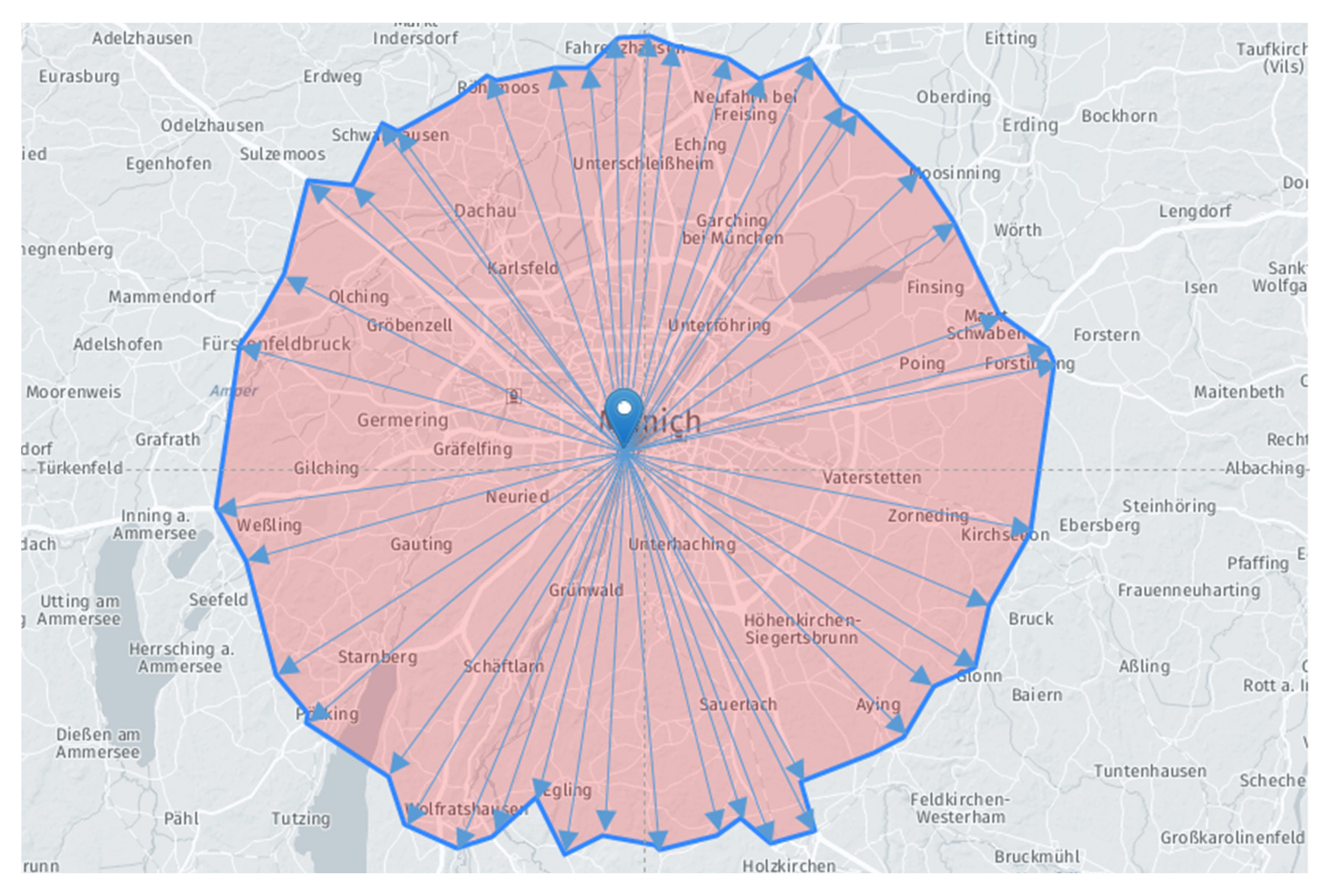
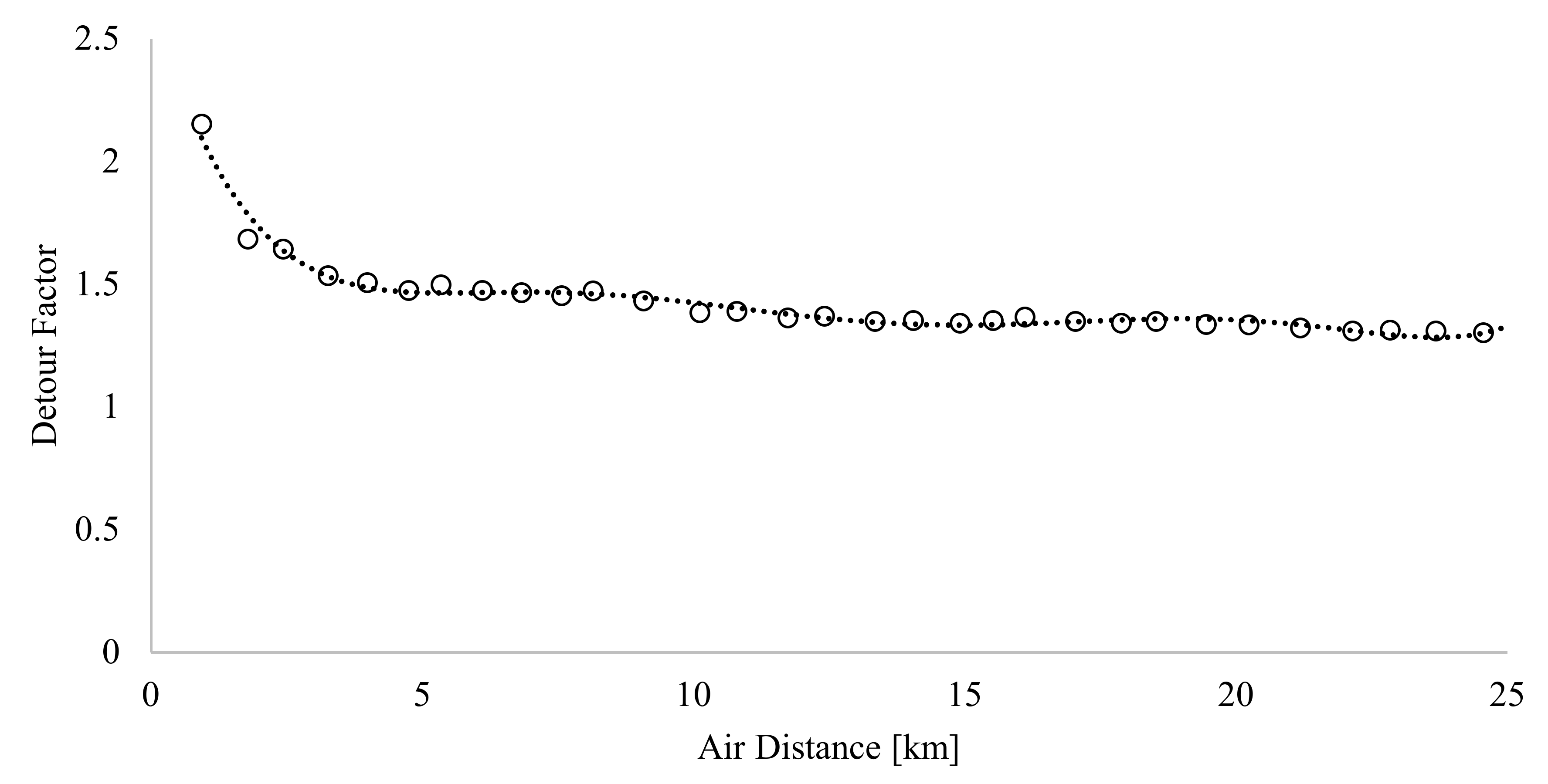

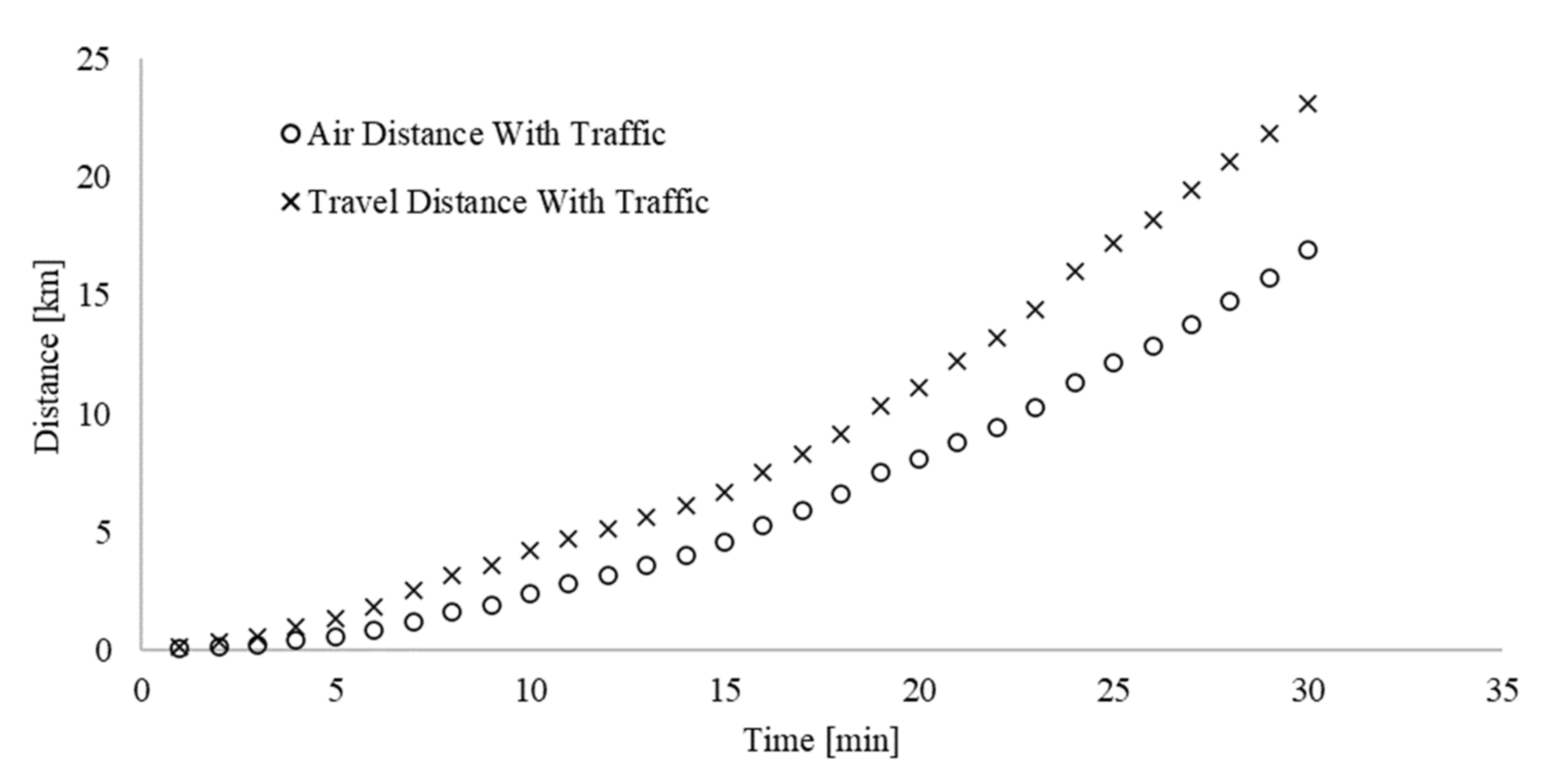

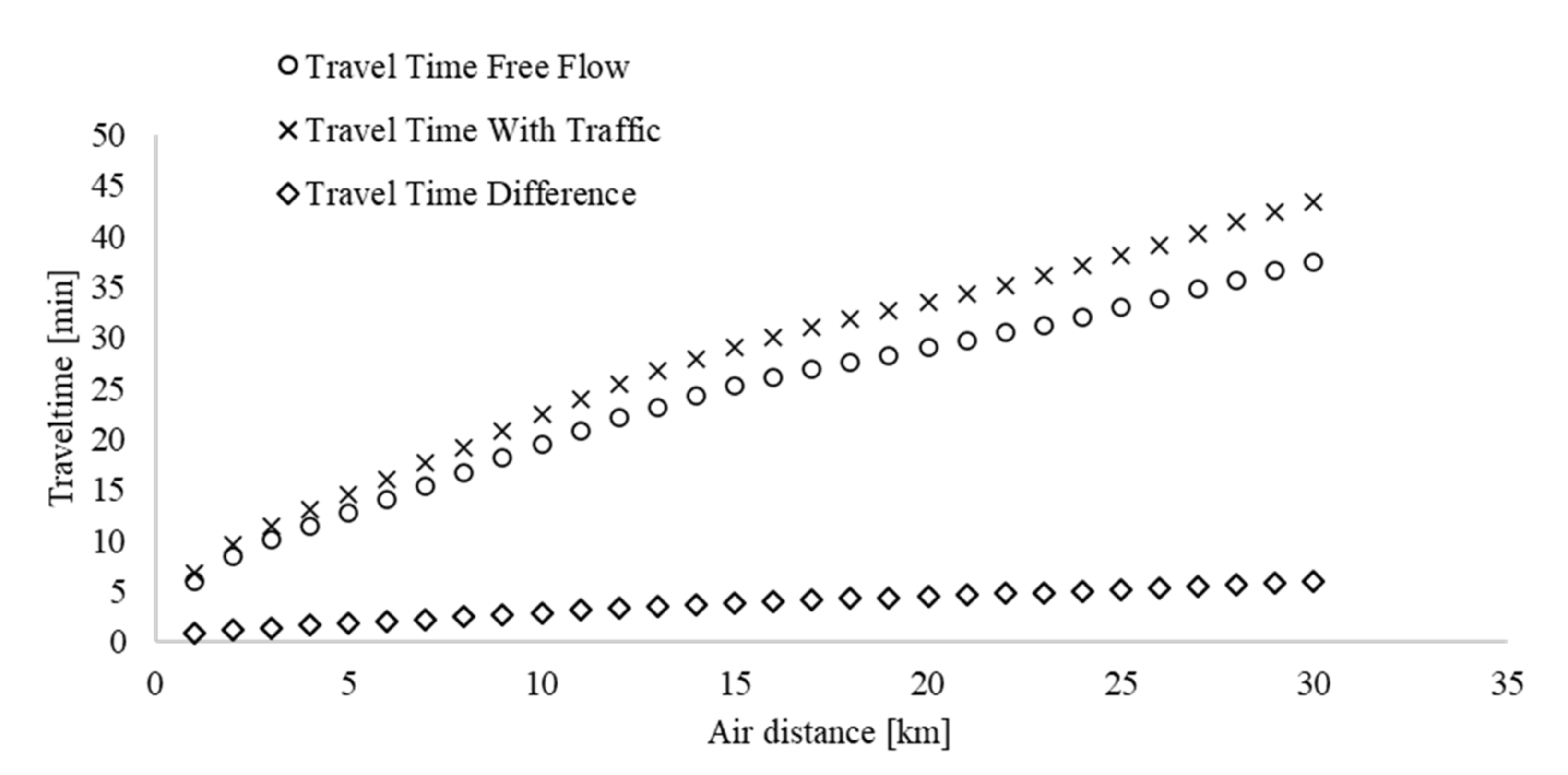
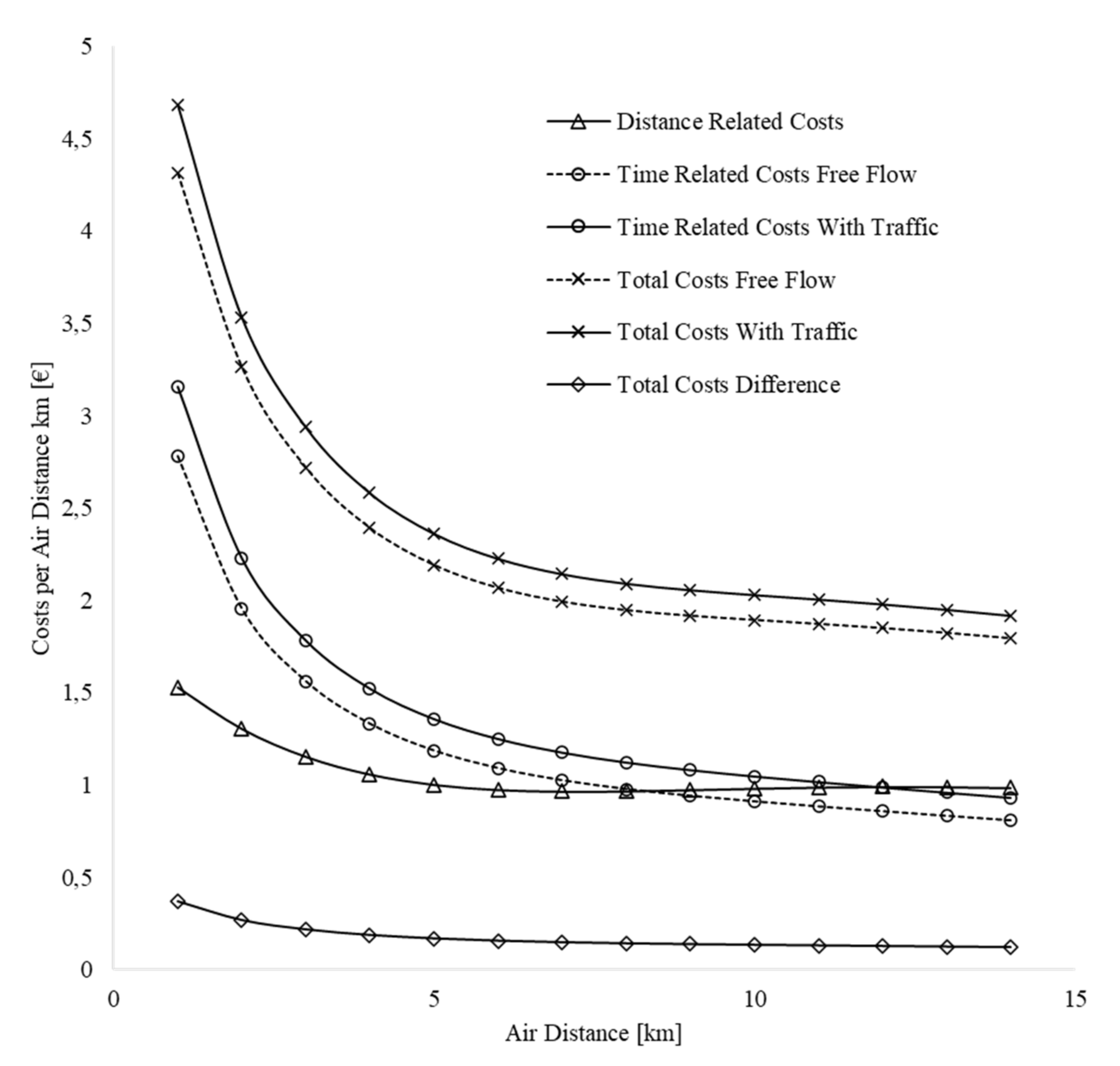




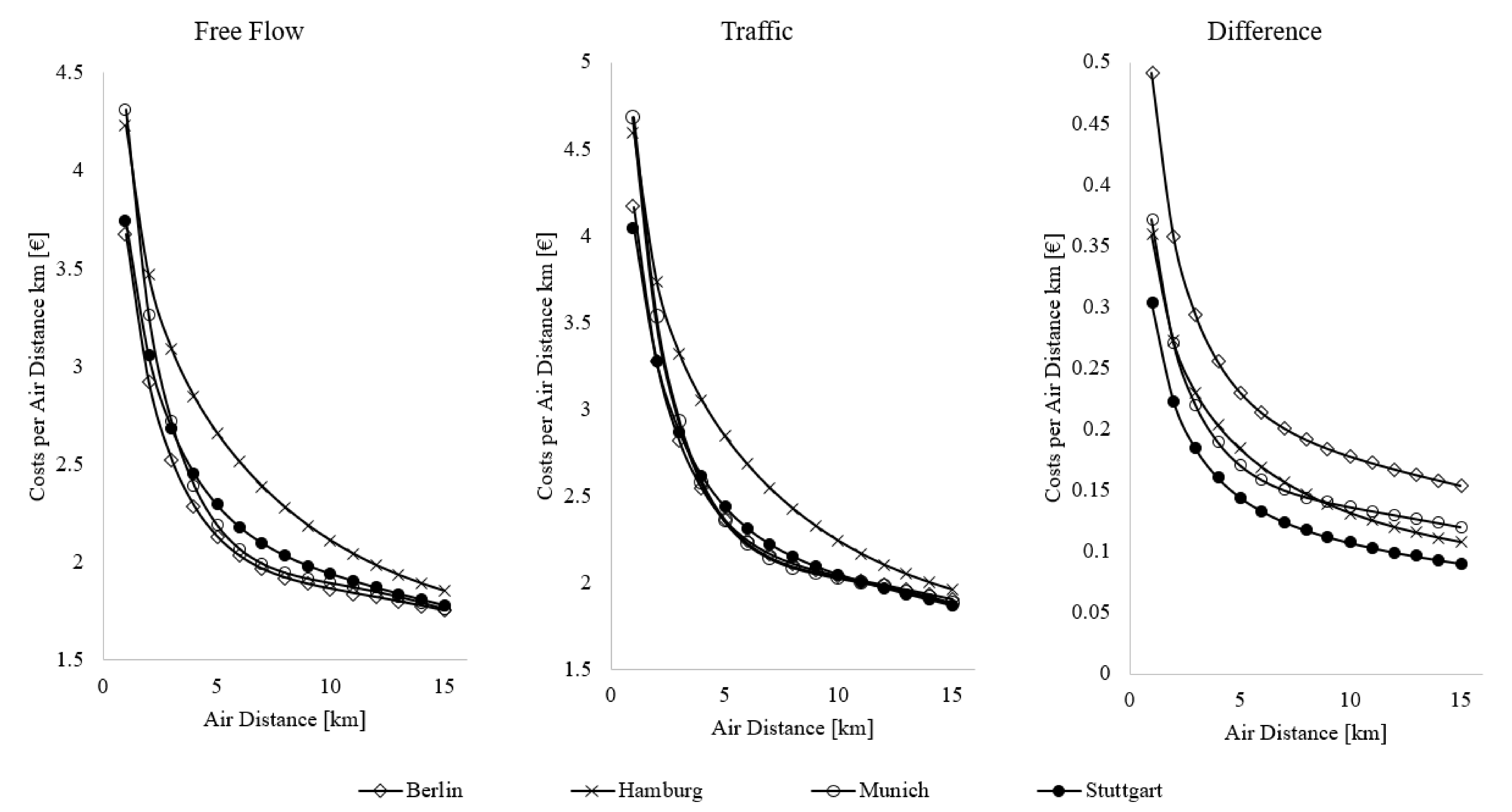
| Parameter | Unit/Format | Description |
|---|---|---|
| Origin | Latitude, Longitude | Origin describes the starting point of the request. |
| Time Budget | Seconds | Time restriction that limits the maximum travel time. |
| Distance Budget | Meters | Distance restriction that restricts the maximum travel distance. |
| Route Type | Fastest; Shortest; Eco | Describes the routing mode. Fastest optimizes travel times, shortest travel distance, eco finds a compromise. |
| Depart At | Date in the RFC 3339 Format | Start time of all fictitious routes. Must be in the future. |
| Travel Mode | Van/Truck/Car | Historical speed profiles that are used depending on the vehicle type. |
| Variable. | Description | Explanation |
|---|---|---|
| Travel distance | The road distance from a start point to an end point | |
| Air distance | Air distance with where is the air distance between the polygon’s corner point and the request’s origin and is the number of polygon corner points (in our case 50). | |
| Travel time | The time needed to travel from a start point to an end point | |
| Detour Factor regression | Continuous Detour Factor regression based on discrete measures | |
| Free flow velocity regression | Continuous free flow velocity regression based on discrete measures | |
| Congested velocity regression | Continuous congested velocity regression based on discrete measures |
| Calculation Step | 1: Detour Factor | 2: Infrastructure/Free Flow | 3: Traffic Congestion |
|---|---|---|---|
| API Restriction | . | ||
| API Result | Polygon to estimate average reachable | ||
| Deduced information | Polynomial regression | Power Regression | Power Regression |
| City | Latitude | Longitude | Street-Level Address |
|---|---|---|---|
| Berlin | 52.519051 | 13.408583 | Berliner Innenstadt, 10178 Berlin |
| Hamburg | 53.551181 | 9.992416 | Alter Wall, 20095 Hamburg |
| Munich | 48.116363 | 11.556560 | Schäftlarnstraße, 81371 Munich |
| Stuttgart | 48.776248 | 9.180116 | Dorotheenstraße, 70173 Stuttgart |
© 2020 by the authors. Licensee MDPI, Basel, Switzerland. This article is an open access article distributed under the terms and conditions of the Creative Commons Attribution (CC BY) license (http://creativecommons.org/licenses/by/4.0/).
Share and Cite
Braun, M.; Kunkler, J.; Kellner, F. Towards Sustainable Cities: Utilizing Floating Car Data to Support Location-Based Road Network Performance Measurements. Sustainability 2020, 12, 8145. https://doi.org/10.3390/su12198145
Braun M, Kunkler J, Kellner F. Towards Sustainable Cities: Utilizing Floating Car Data to Support Location-Based Road Network Performance Measurements. Sustainability. 2020; 12(19):8145. https://doi.org/10.3390/su12198145
Chicago/Turabian StyleBraun, Maximilian, Jan Kunkler, and Florian Kellner. 2020. "Towards Sustainable Cities: Utilizing Floating Car Data to Support Location-Based Road Network Performance Measurements" Sustainability 12, no. 19: 8145. https://doi.org/10.3390/su12198145
APA StyleBraun, M., Kunkler, J., & Kellner, F. (2020). Towards Sustainable Cities: Utilizing Floating Car Data to Support Location-Based Road Network Performance Measurements. Sustainability, 12(19), 8145. https://doi.org/10.3390/su12198145







